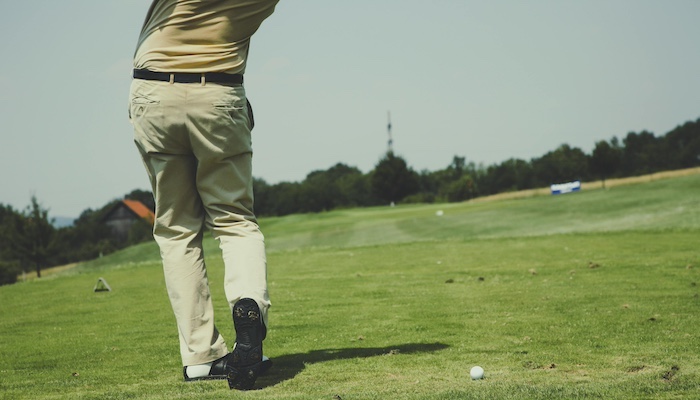
Golf is a favorite sport and pastime among many. However, the torque and force applied across the lower back pain creates a significant risk for developing or worsening lower back pain. People who suffer from chronic or recurrent episodes of low back pain can be frustrated because the pain hinders their ability to play golf.
The Golf Swing Stresses the Lower Back
The force, torque, and twisting of structures in the lower back create a significant risk of injury to the lower back. The swing of a golf club naturally involves an incredible amount of force from only one side of the body, unevenly placing pressure on the spine. During a golf swing, the lower back sustains a compressive force of:
- About 1370 pounds for amateur golfers
- About 1700 pounds for professional golfers
For comparison, college football players experience a compressive force of about 1950 pounds while hitting a football-blocking sled. Approximately 1220 pounds of force are needed for a disc to herniate.
Mechanics of incorrect swing techniques and habits that pose a risk to the spine include:
- Bending too far to the trailing side during the forward swing, placing excessive force on the trailing side
- Prolonging the swing by rotating the body beyond its range of motion, increases the risk of injury
- Engaging muscles inadequately or engaging the wrong muscles, makes the muscles prone to tearing
- Rotating the leg inward at the hip with a narrow range of motion risks injury to the hip
- Having weak core muscles increases the risk of muscle strain
- Playing golf for extended periods leads to muscle fatigue
Simple solutions to address these risk factors will prevent or reduce episodes of back pain. For example, learning the mechanics of the swing helps players with any level of experience in golf. Professionals are usually available for assistance at golf courses.
Symptoms of Golf-Related Low Back Pain
Symptoms may arise gradually or suddenly, and may include one or more of the following:
- Dull ache on one side of the lower back. Lower back pain from golf may be felt on the right side for the right-handed golfer and the left side for the left-handed golfer. The trailing side typically experiences the greatest force during the swing.
- Pain that extends to the hip or thigh. Common spinal disorders, such as facet joint syndrome or sacroiliac joint dysfunction, can be exacerbated by golfing and result in additional dull pain below the lower back.
- Nerve pain in the leg. Sharp, electric pain or numbness can occur in the leg when a herniated disc presses on a nerve.
- Stiffness in the lower back. Low back pain often limits the range of motion in the lower back and/or the hips, leading to difficulty with bending or walking uphill.
- Lordosis. The natural inward curve of the lower back can deepen when core muscles are strained. Such an arch leads to worsening lower back pain.
Weaker core and pelvic muscles that are the source of low back pain can be identified by accompanying symptoms. For example, the transversus abdominis (TVA) lies deep in the abdomen and envelops the left and right flanks in the lower back. Low back pain from a weak transversus abdominis may coincide with a slouched posture, weak balance, or a bulge in the stomach when performing abdominal exercises.
Golf-related pain is not limited to the lower back. Middle back (thoracic) pain from golf and upper back pain from golf may also occur without warning, even on the golf course. The sudden pain may be described as sharp or stabbing and is usually a result of overworked muscles. Pain in the middle or upper back may be related to an overworked erector spina, a set of 3 muscles that start near the sacrum and run upward along the sides of the vertebral column. When faced with physically demanding movements, the erector spinae compensate for weakness in the larger core muscles and lower back muscles, and are prone to muscle strain anywhere along the back as a result.
Health Benefits of Regular Golfing
For avid golfers with recurring episodes of back pain, continuing to play the sport is usually possible and, when done correctly, can be an excellent part of an ongoing exercise program.
Benefits of playing golf include:
- Improved cardiovascular health. Golf is an excellent low-impact aerobic exercise, which is often recommended for individuals with back pain. The average golfer may have a driving distance of about 200 yards, which is the size of 2 football fields. So, by the time the course of 18 holes comes to an end, players have usually walked 3 or more miles.
- Fresh outdoor air. Older adults in particular may relish golf as an outdoor activity. Golf is a way to exercise outside of a stuffy, crowded gym and to enjoy time outside of the house. Naturally, the fresh air helps with reducing anxiety and depression, and sunlight exposure provides much-needed vitamin D.
- Social interactions. The sport can be enjoyed as a family, group of friends, or business. Golfers who arrive at the golf course alone can join other groups and find new companies, as well.
Many golf enthusiasts find that the health benefits of golf outweigh the risk of back pain, which can be managed and even prevented.
Precision Pain Care and Rehabilitation has two convenient locations in Richmond Hill – Queens, and New Hyde Park – Long Island. Call the Queens office at (718) 215-1888 or (516) 419-4480 for the Long Island office to arrange an appointment with our Interventional Pain Management Specialists, Dr. Jeffrey Chacko or Dr. Sonny Ahluwalia.













